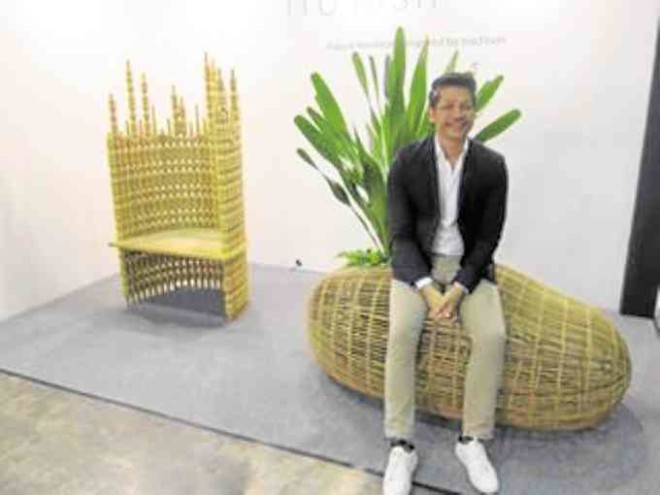
There was a surfeit of riches at the annual Singapore Design Week (SDW) held earlier this month.
This fourth edition celebrated all things design with over 100 local and international events, and programs. Organized by the DesignSingaporeCouncil (Dsg) and supported by key and fringe partners, this year’s event ran from March 3 to 12 at the National Design Centre and in various locations across Singapore.
As a guest of the Singapore Tourism Board, we were also able to view key exhibits at the International Furniture Fair Singapore (IFFS) at the Singapore Expo, and SingaPlural 2017 at the F1 Pit Building.
At the National Design Centre, jewelry designer Carolyn Kan of Carrie K Artisan Jewelry, presented new pieces from her “Beauty and the Beast” collaboration with Disney. She and her team came up with cubic zirconia-dusted rings and pendants featuring the Beast’s stylized fangs.
Instead of the enchanted rose, however, they chose solitary pearls to symbolize Beauty.
Kan had also designed a pendant for Singapore Airlines which is marking its 70th anniversary this year. “I wanted to come up with a design that the wearer could use more than one way because when people travel, they don’t usually bring a pile of jewelry,” Kan said.
Her North Star pendant that symbolizes travel hangs from a thin silver necklace and can be used alone or with the stylized four-leaf clover that symbolizes luck or good fortune. The clover pendant can likewise be worn alone. One side is smooth while the other side has cubic zirconia.
It was this multi-use, multipurpose design philosophy that resonated at SDW. We saw it during the Furniture Design Award (FDA) showcase, where the designs of the 12 finalists chosen from 259 entries from 35 countries were on display.
Lone Filipino finalist
The lone Filipino finalist, Jun Paul Lasco of Cebu, came up with the Bench Screen, a high-backed bench that serves as seating and as a partition or divider.
“I was inspired by the inexpensive reed screens sold by ambulant vendors,” Lasco told Lifestyle. “Two Christmases ago, my mother came home with several of these screens. She said that after seeing an old woman selling them, she decided to buy all her wares.”
The elderly woman was so thankful because she didn’t have to go around Bohol trying to sell the screens. She was able to go home to her family with money to spend for noche buena.
“That’s where the idea for the Bench Screen came from. I wanted to elevate the look by using sturdier materials but still keeping its screen function,” Lasco said.
By using rattan in a gradient pattern attached to a lightweight steel frame, he was able to come up with seating that also provided a modicum of privacy. “It’s still very new but I can imagine it being used in airports, banks and restaurants,” he said. “Clients can also have the steel frame painted in their preferred color.”
The soft-spoken designer added that he has been working for industrial designer Kenneth Cobonpue for the past two years.
“The Bench Screen may look simple but I can also come up with elaborate designs should the need arise,” said Lasco.
Designer and store owner Ito Kish was one of the exhibitors. His Binhi design had two purposes. (Binhi is Filipino for seed.) Incorporated into the seed-shaped seat made of sturdy rattan was an indentation where one could place a potted plant, in keeping with the binhi theme.
“Depending on your size, you can even curl up and lie down on it. We’ve also made the space for the potted plant even sturdier so it can be easily cleaned,” Kish said.
Transforming crib
SingaPlural 2017 at the F1 Pit Building was a visual treat. As SDW’s annual anchor event, it presented new perspectives with a refreshing take on design and how it influences daily life.
From more than 100 designs on display, the one that caught our eye was the baby’s crib at the KYO Project, the first collaboration between the Kanto Bureau of Economy, Trade & Industry (METI-Kanto), Japanese craft makers and Singaporean designers.
Unlike traditional cribs that can be used for only a couple of years, the one designed by Tree to Green (Japan) and WOHA (Singapore) can be modified following the baby’s growth and development.
Made from Hinoki cypress wood with natural antibacterial properties, the crib can be transformed into a toddler bed or into a table or a sideboard with drawers.
The designers—Takanori Kosegi of Nagano in Japan, and Wong Mun Summ and Richard Hassell of Singapore—looked beyond a crib’s use and came up with a flexible design.
‘Deep capabilities’
“Given the pace of technological change and advent of disruptive business models, Singapore needs to focus on building deep capabilities in our industries, to be well-positioned for the challenges and opportunities arising from these changes,” said trade and industry minister S. Iswaran at the opening of the IFFS.
To this end, the IFFS this year included a Virtual Reality Zone that demonstrated how trade show modes are evolving. Although nothing beats touching and sitting on a sofa or bench, viewing pieces in virtual reality mode is a new option.
“These technologies allow customers to create digital mockups of their rooms to better select furniture across a wider range of designs,” Iswaran said.
In these quickly changing times, design has to evolve just as quickly to remain fresh and relevant.